MGT600 - HRM Strategies for ComSyst Technologies: A Case Analysis
VerifiedAdded on 2023/06/10
|22
|4490
|268
Case Study
AI Summary
This case study examines the human resource management (HRM) challenges faced by ComSyst Technologies (CST), a multinational communications and software company operating in a highly competitive industry. The report identifies key issues such as low employee engagement, declining staff retention, resignation of specialists, and gaps in technical skills. The company aims to attract and retain top talent, create a high-performance culture, and build employee capability. The analysis incorporates theoretical concepts and real-world examples, such as FedEx's employee recruitment and retention methods, to provide a comprehensive understanding of the issues. Recommendations are provided for acquiring and retaining talent through better compensation and growth opportunities, fostering a high-performance culture through collaboration, innovation, and agility, and improving employee capability through targeted training programs. The report concludes by emphasizing the importance of strategic HRM in achieving organizational success.
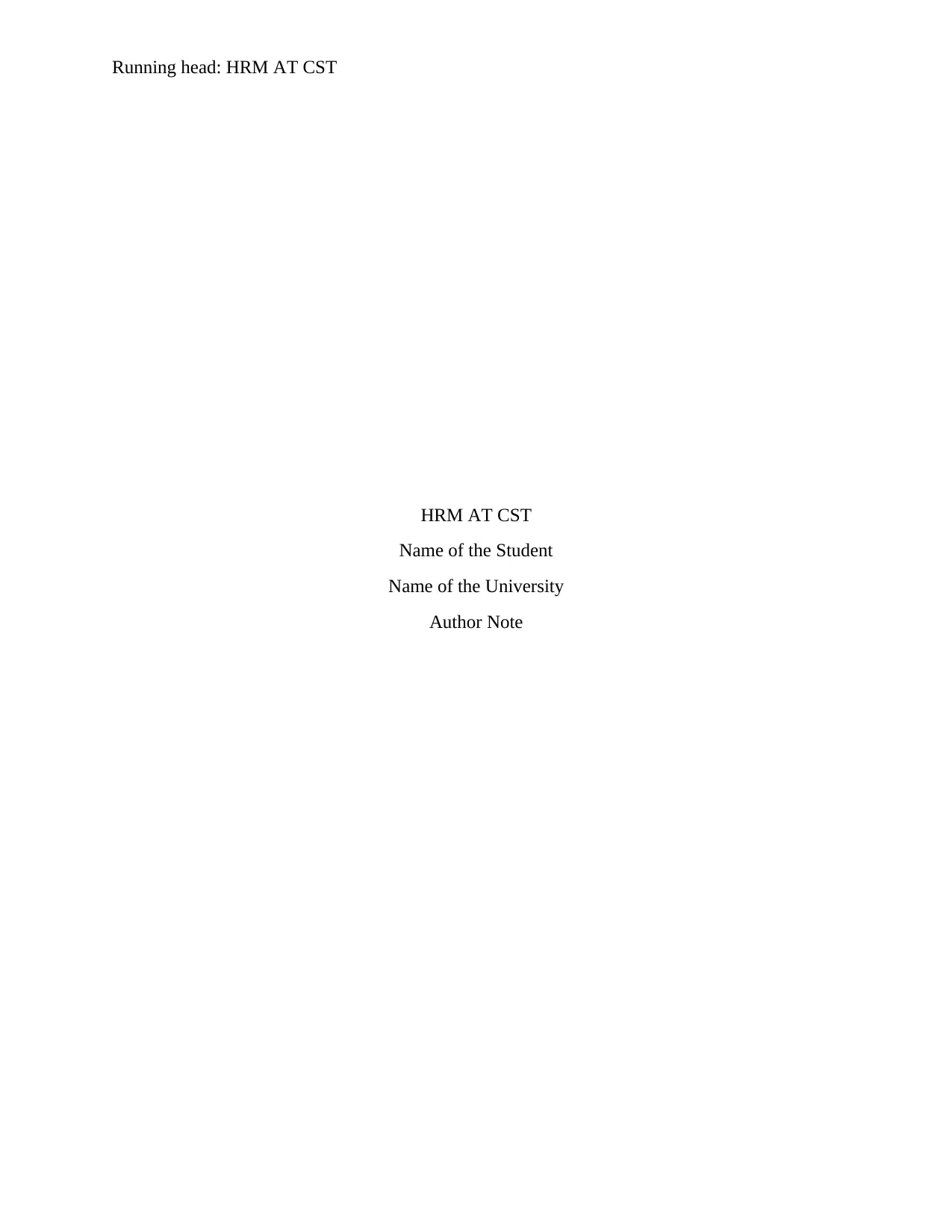
Running head: HRM AT CST
HRM AT CST
Name of the Student
Name of the University
Author Note
HRM AT CST
Name of the Student
Name of the University
Author Note
Paraphrase This Document
Need a fresh take? Get an instant paraphrase of this document with our AI Paraphraser
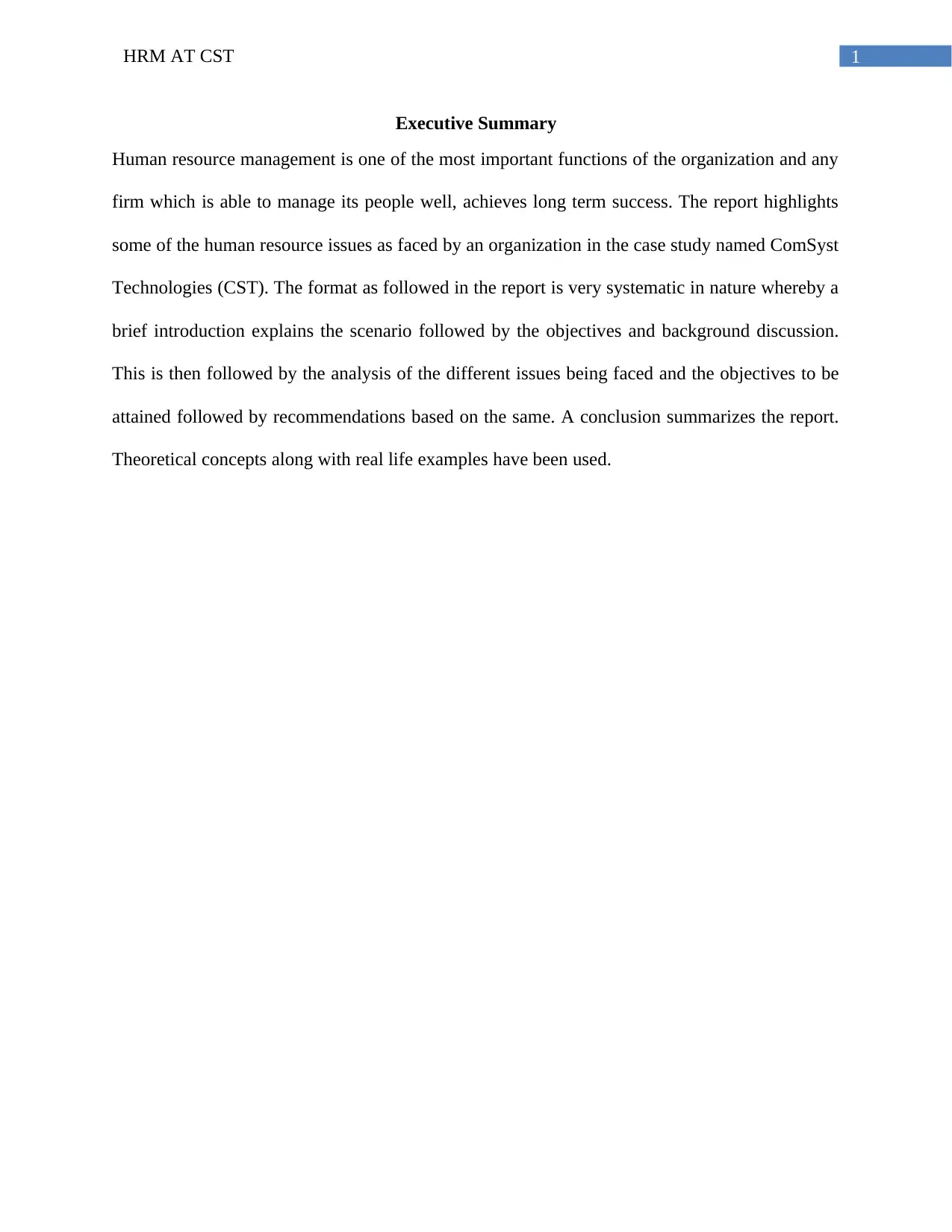
1HRM AT CST
Executive Summary
Human resource management is one of the most important functions of the organization and any
firm which is able to manage its people well, achieves long term success. The report highlights
some of the human resource issues as faced by an organization in the case study named ComSyst
Technologies (CST). The format as followed in the report is very systematic in nature whereby a
brief introduction explains the scenario followed by the objectives and background discussion.
This is then followed by the analysis of the different issues being faced and the objectives to be
attained followed by recommendations based on the same. A conclusion summarizes the report.
Theoretical concepts along with real life examples have been used.
Executive Summary
Human resource management is one of the most important functions of the organization and any
firm which is able to manage its people well, achieves long term success. The report highlights
some of the human resource issues as faced by an organization in the case study named ComSyst
Technologies (CST). The format as followed in the report is very systematic in nature whereby a
brief introduction explains the scenario followed by the objectives and background discussion.
This is then followed by the analysis of the different issues being faced and the objectives to be
attained followed by recommendations based on the same. A conclusion summarizes the report.
Theoretical concepts along with real life examples have been used.
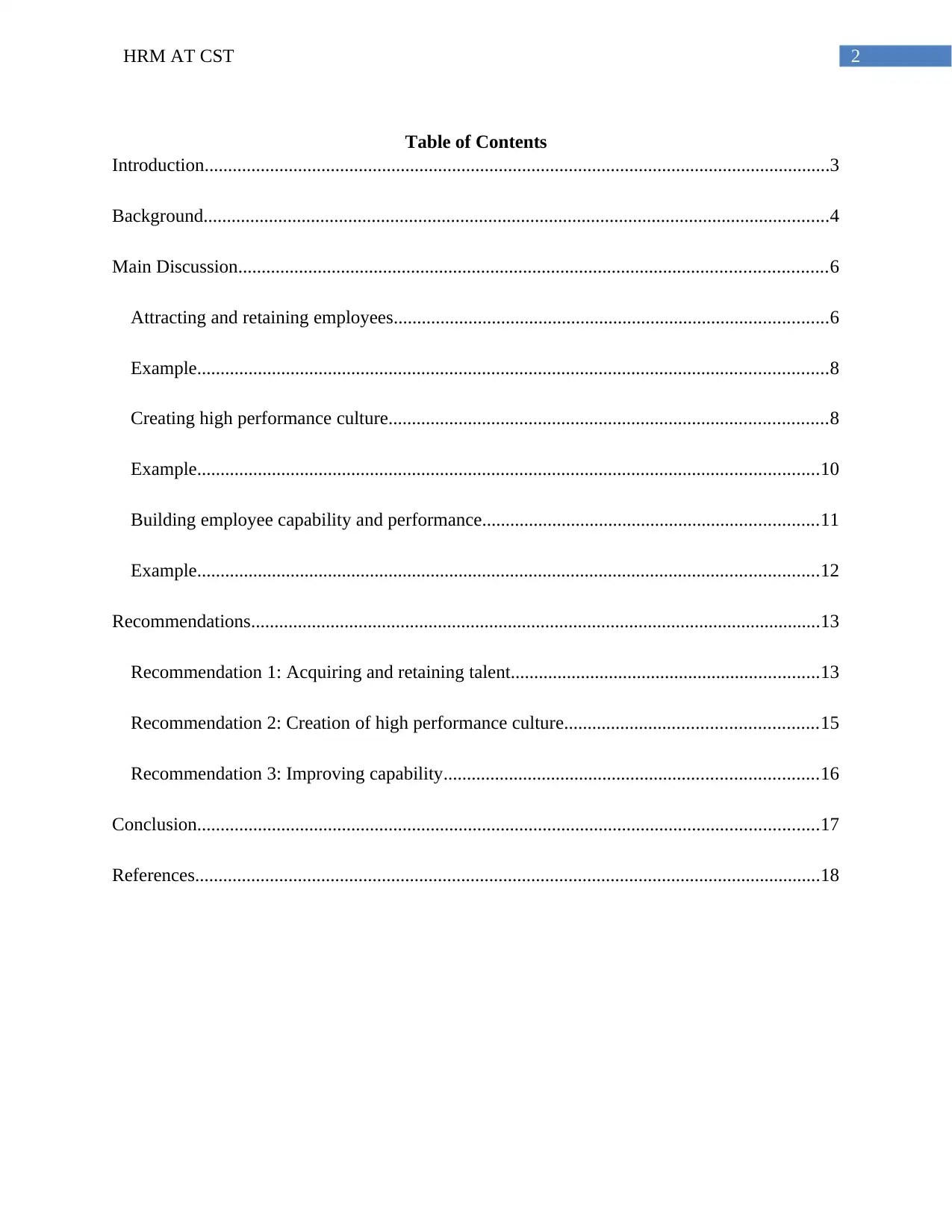
2HRM AT CST
Table of Contents
Introduction......................................................................................................................................3
Background......................................................................................................................................4
Main Discussion..............................................................................................................................6
Attracting and retaining employees.............................................................................................6
Example.......................................................................................................................................8
Creating high performance culture..............................................................................................8
Example.....................................................................................................................................10
Building employee capability and performance........................................................................11
Example.....................................................................................................................................12
Recommendations..........................................................................................................................13
Recommendation 1: Acquiring and retaining talent..................................................................13
Recommendation 2: Creation of high performance culture......................................................15
Recommendation 3: Improving capability................................................................................16
Conclusion.....................................................................................................................................17
References......................................................................................................................................18
Table of Contents
Introduction......................................................................................................................................3
Background......................................................................................................................................4
Main Discussion..............................................................................................................................6
Attracting and retaining employees.............................................................................................6
Example.......................................................................................................................................8
Creating high performance culture..............................................................................................8
Example.....................................................................................................................................10
Building employee capability and performance........................................................................11
Example.....................................................................................................................................12
Recommendations..........................................................................................................................13
Recommendation 1: Acquiring and retaining talent..................................................................13
Recommendation 2: Creation of high performance culture......................................................15
Recommendation 3: Improving capability................................................................................16
Conclusion.....................................................................................................................................17
References......................................................................................................................................18
⊘ This is a preview!⊘
Do you want full access?
Subscribe today to unlock all pages.

Trusted by 1+ million students worldwide
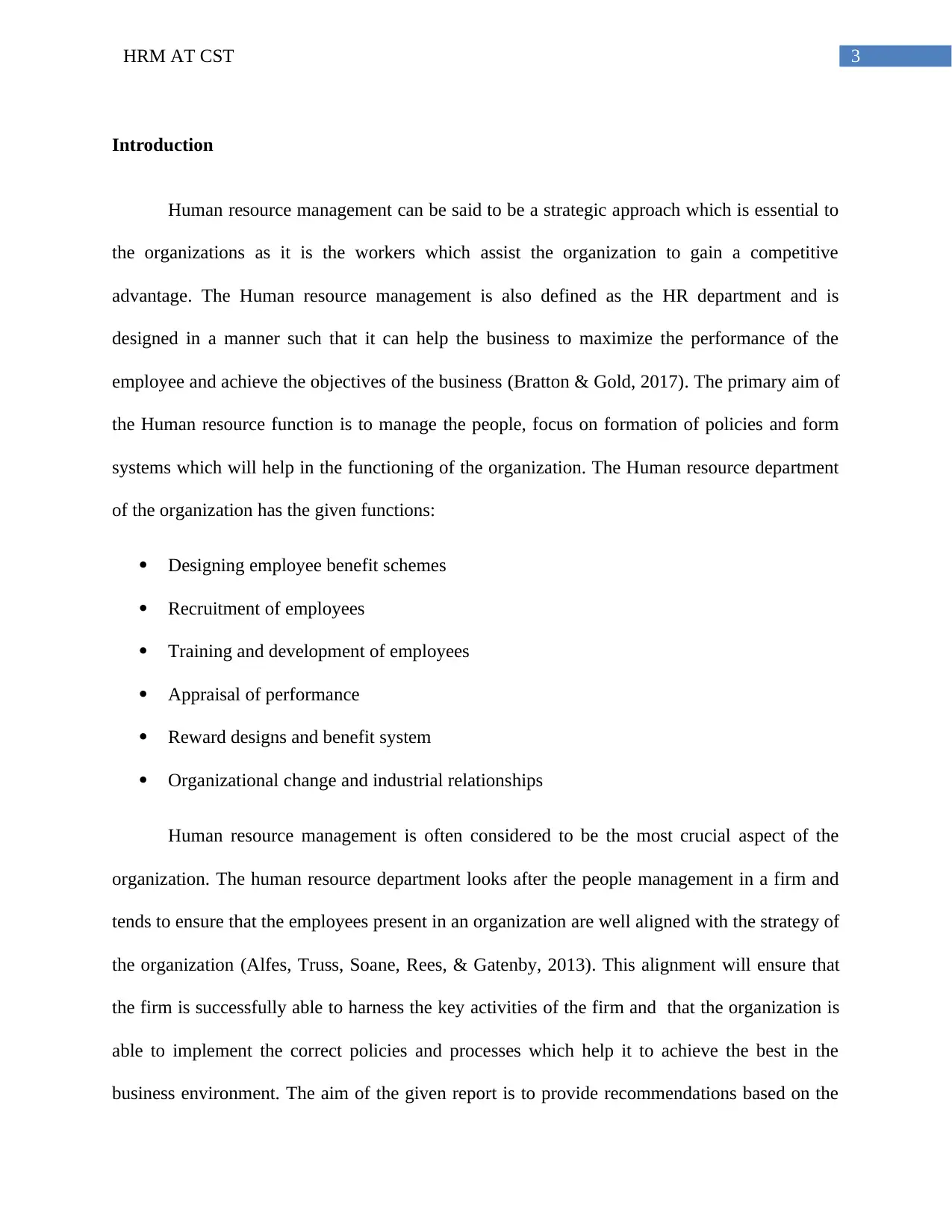
3HRM AT CST
Introduction
Human resource management can be said to be a strategic approach which is essential to
the organizations as it is the workers which assist the organization to gain a competitive
advantage. The Human resource management is also defined as the HR department and is
designed in a manner such that it can help the business to maximize the performance of the
employee and achieve the objectives of the business (Bratton & Gold, 2017). The primary aim of
the Human resource function is to manage the people, focus on formation of policies and form
systems which will help in the functioning of the organization. The Human resource department
of the organization has the given functions:
Designing employee benefit schemes
Recruitment of employees
Training and development of employees
Appraisal of performance
Reward designs and benefit system
Organizational change and industrial relationships
Human resource management is often considered to be the most crucial aspect of the
organization. The human resource department looks after the people management in a firm and
tends to ensure that the employees present in an organization are well aligned with the strategy of
the organization (Alfes, Truss, Soane, Rees, & Gatenby, 2013). This alignment will ensure that
the firm is successfully able to harness the key activities of the firm and that the organization is
able to implement the correct policies and processes which help it to achieve the best in the
business environment. The aim of the given report is to provide recommendations based on the
Introduction
Human resource management can be said to be a strategic approach which is essential to
the organizations as it is the workers which assist the organization to gain a competitive
advantage. The Human resource management is also defined as the HR department and is
designed in a manner such that it can help the business to maximize the performance of the
employee and achieve the objectives of the business (Bratton & Gold, 2017). The primary aim of
the Human resource function is to manage the people, focus on formation of policies and form
systems which will help in the functioning of the organization. The Human resource department
of the organization has the given functions:
Designing employee benefit schemes
Recruitment of employees
Training and development of employees
Appraisal of performance
Reward designs and benefit system
Organizational change and industrial relationships
Human resource management is often considered to be the most crucial aspect of the
organization. The human resource department looks after the people management in a firm and
tends to ensure that the employees present in an organization are well aligned with the strategy of
the organization (Alfes, Truss, Soane, Rees, & Gatenby, 2013). This alignment will ensure that
the firm is successfully able to harness the key activities of the firm and that the organization is
able to implement the correct policies and processes which help it to achieve the best in the
business environment. The aim of the given report is to provide recommendations based on the
Paraphrase This Document
Need a fresh take? Get an instant paraphrase of this document with our AI Paraphraser
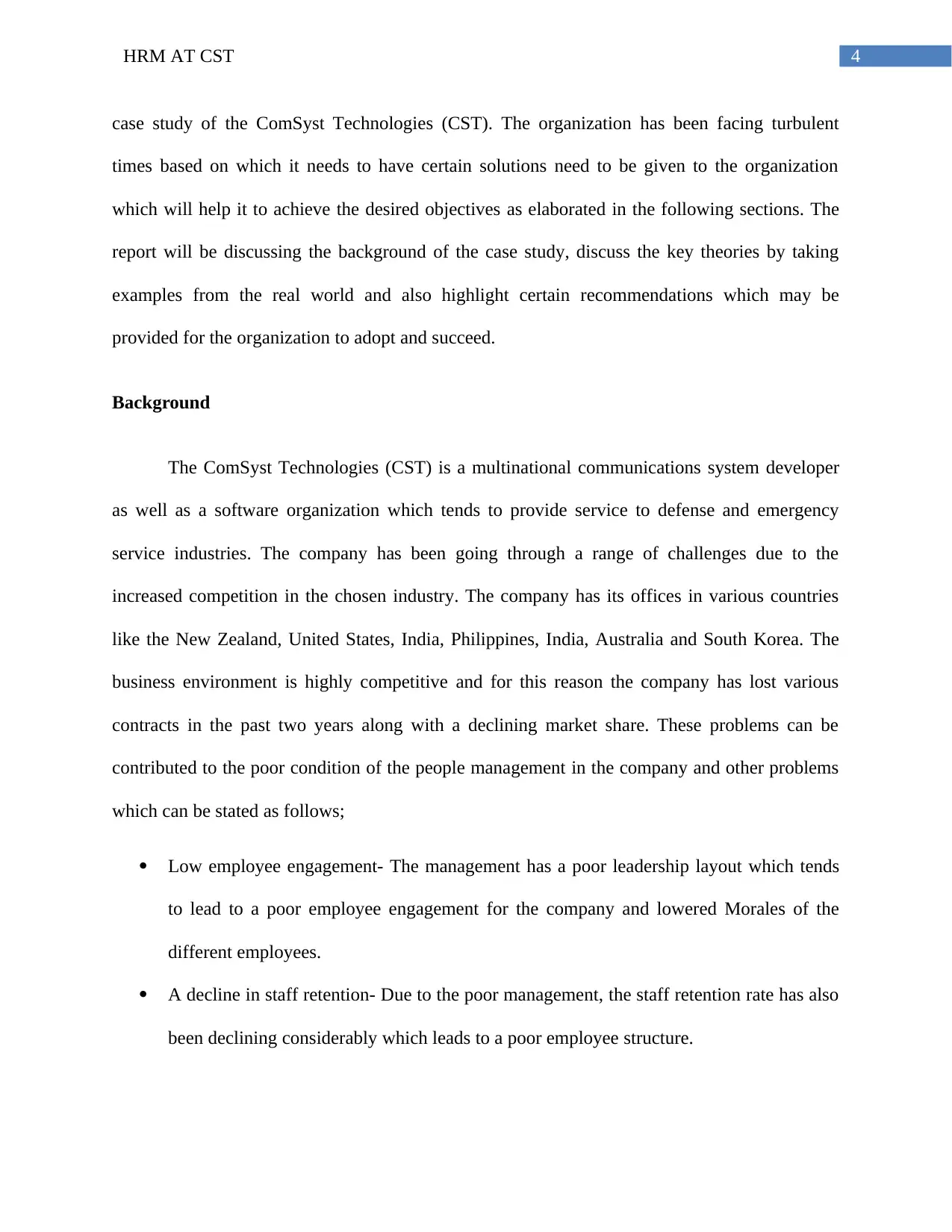
4HRM AT CST
case study of the ComSyst Technologies (CST). The organization has been facing turbulent
times based on which it needs to have certain solutions need to be given to the organization
which will help it to achieve the desired objectives as elaborated in the following sections. The
report will be discussing the background of the case study, discuss the key theories by taking
examples from the real world and also highlight certain recommendations which may be
provided for the organization to adopt and succeed.
Background
The ComSyst Technologies (CST) is a multinational communications system developer
as well as a software organization which tends to provide service to defense and emergency
service industries. The company has been going through a range of challenges due to the
increased competition in the chosen industry. The company has its offices in various countries
like the New Zealand, United States, India, Philippines, India, Australia and South Korea. The
business environment is highly competitive and for this reason the company has lost various
contracts in the past two years along with a declining market share. These problems can be
contributed to the poor condition of the people management in the company and other problems
which can be stated as follows;
Low employee engagement- The management has a poor leadership layout which tends
to lead to a poor employee engagement for the company and lowered Morales of the
different employees.
A decline in staff retention- Due to the poor management, the staff retention rate has also
been declining considerably which leads to a poor employee structure.
case study of the ComSyst Technologies (CST). The organization has been facing turbulent
times based on which it needs to have certain solutions need to be given to the organization
which will help it to achieve the desired objectives as elaborated in the following sections. The
report will be discussing the background of the case study, discuss the key theories by taking
examples from the real world and also highlight certain recommendations which may be
provided for the organization to adopt and succeed.
Background
The ComSyst Technologies (CST) is a multinational communications system developer
as well as a software organization which tends to provide service to defense and emergency
service industries. The company has been going through a range of challenges due to the
increased competition in the chosen industry. The company has its offices in various countries
like the New Zealand, United States, India, Philippines, India, Australia and South Korea. The
business environment is highly competitive and for this reason the company has lost various
contracts in the past two years along with a declining market share. These problems can be
contributed to the poor condition of the people management in the company and other problems
which can be stated as follows;
Low employee engagement- The management has a poor leadership layout which tends
to lead to a poor employee engagement for the company and lowered Morales of the
different employees.
A decline in staff retention- Due to the poor management, the staff retention rate has also
been declining considerably which leads to a poor employee structure.
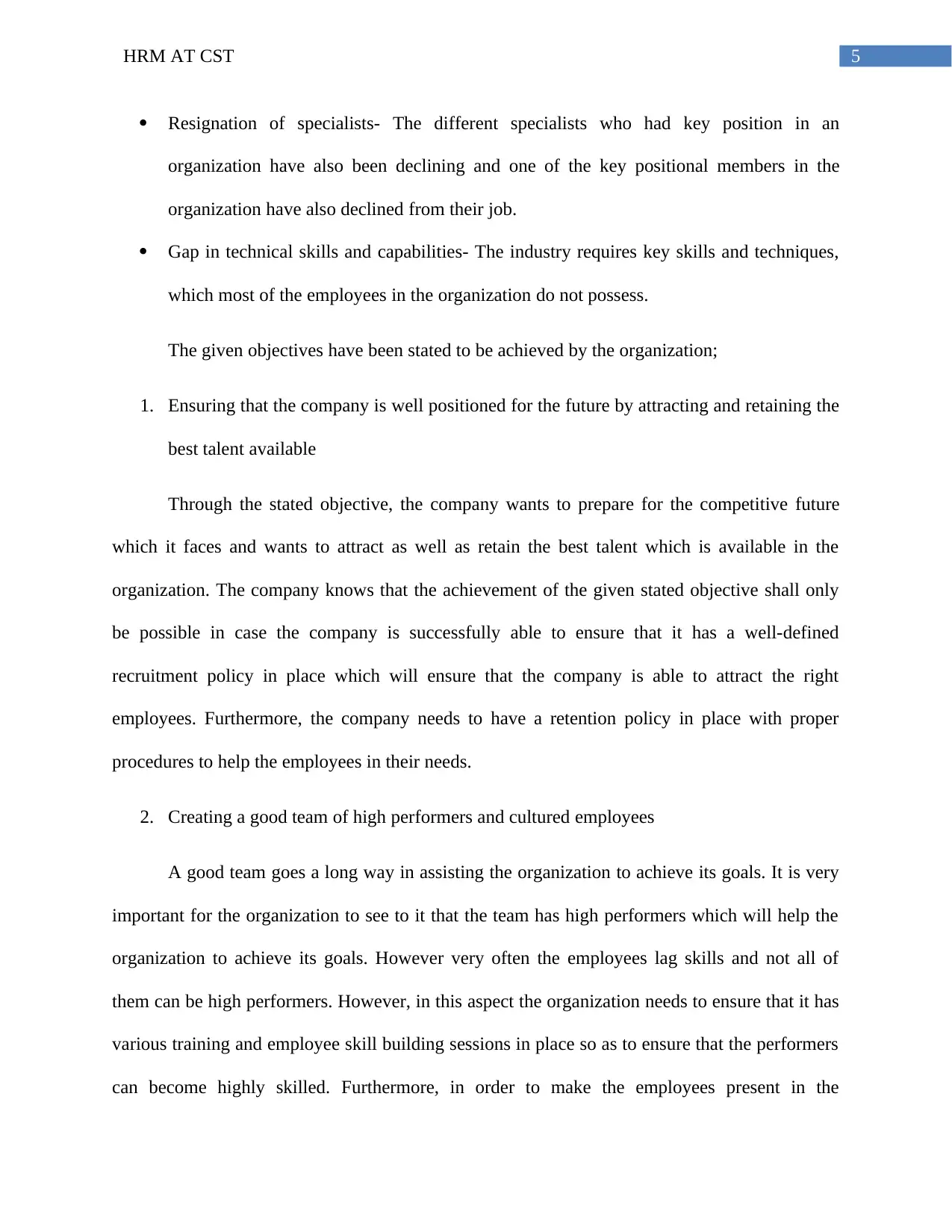
5HRM AT CST
Resignation of specialists- The different specialists who had key position in an
organization have also been declining and one of the key positional members in the
organization have also declined from their job.
Gap in technical skills and capabilities- The industry requires key skills and techniques,
which most of the employees in the organization do not possess.
The given objectives have been stated to be achieved by the organization;
1. Ensuring that the company is well positioned for the future by attracting and retaining the
best talent available
Through the stated objective, the company wants to prepare for the competitive future
which it faces and wants to attract as well as retain the best talent which is available in the
organization. The company knows that the achievement of the given stated objective shall only
be possible in case the company is successfully able to ensure that it has a well-defined
recruitment policy in place which will ensure that the company is able to attract the right
employees. Furthermore, the company needs to have a retention policy in place with proper
procedures to help the employees in their needs.
2. Creating a good team of high performers and cultured employees
A good team goes a long way in assisting the organization to achieve its goals. It is very
important for the organization to see to it that the team has high performers which will help the
organization to achieve its goals. However very often the employees lag skills and not all of
them can be high performers. However, in this aspect the organization needs to ensure that it has
various training and employee skill building sessions in place so as to ensure that the performers
can become highly skilled. Furthermore, in order to make the employees present in the
Resignation of specialists- The different specialists who had key position in an
organization have also been declining and one of the key positional members in the
organization have also declined from their job.
Gap in technical skills and capabilities- The industry requires key skills and techniques,
which most of the employees in the organization do not possess.
The given objectives have been stated to be achieved by the organization;
1. Ensuring that the company is well positioned for the future by attracting and retaining the
best talent available
Through the stated objective, the company wants to prepare for the competitive future
which it faces and wants to attract as well as retain the best talent which is available in the
organization. The company knows that the achievement of the given stated objective shall only
be possible in case the company is successfully able to ensure that it has a well-defined
recruitment policy in place which will ensure that the company is able to attract the right
employees. Furthermore, the company needs to have a retention policy in place with proper
procedures to help the employees in their needs.
2. Creating a good team of high performers and cultured employees
A good team goes a long way in assisting the organization to achieve its goals. It is very
important for the organization to see to it that the team has high performers which will help the
organization to achieve its goals. However very often the employees lag skills and not all of
them can be high performers. However, in this aspect the organization needs to ensure that it has
various training and employee skill building sessions in place so as to ensure that the performers
can become highly skilled. Furthermore, in order to make the employees present in the
⊘ This is a preview!⊘
Do you want full access?
Subscribe today to unlock all pages.

Trusted by 1+ million students worldwide
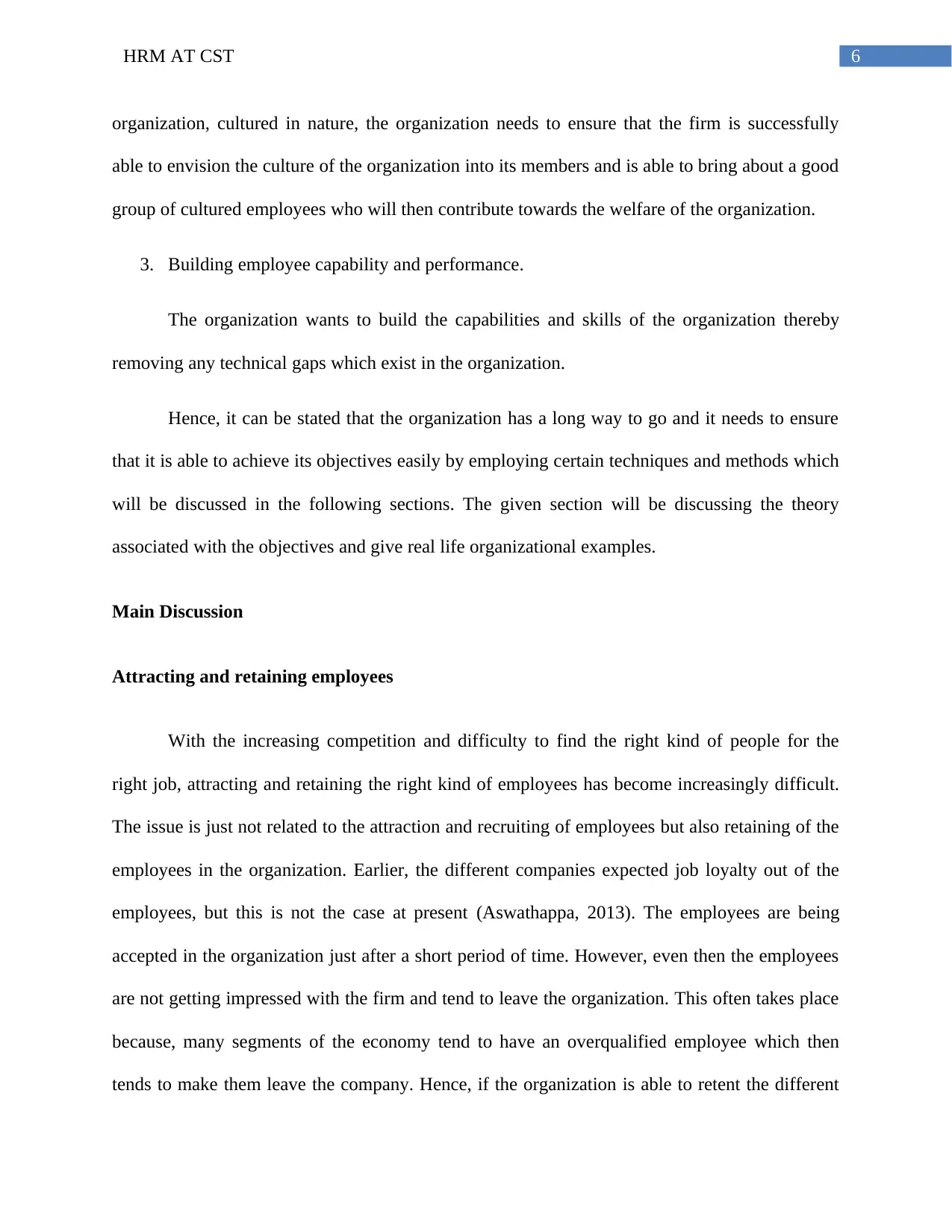
6HRM AT CST
organization, cultured in nature, the organization needs to ensure that the firm is successfully
able to envision the culture of the organization into its members and is able to bring about a good
group of cultured employees who will then contribute towards the welfare of the organization.
3. Building employee capability and performance.
The organization wants to build the capabilities and skills of the organization thereby
removing any technical gaps which exist in the organization.
Hence, it can be stated that the organization has a long way to go and it needs to ensure
that it is able to achieve its objectives easily by employing certain techniques and methods which
will be discussed in the following sections. The given section will be discussing the theory
associated with the objectives and give real life organizational examples.
Main Discussion
Attracting and retaining employees
With the increasing competition and difficulty to find the right kind of people for the
right job, attracting and retaining the right kind of employees has become increasingly difficult.
The issue is just not related to the attraction and recruiting of employees but also retaining of the
employees in the organization. Earlier, the different companies expected job loyalty out of the
employees, but this is not the case at present (Aswathappa, 2013). The employees are being
accepted in the organization just after a short period of time. However, even then the employees
are not getting impressed with the firm and tend to leave the organization. This often takes place
because, many segments of the economy tend to have an overqualified employee which then
tends to make them leave the company. Hence, if the organization is able to retent the different
organization, cultured in nature, the organization needs to ensure that the firm is successfully
able to envision the culture of the organization into its members and is able to bring about a good
group of cultured employees who will then contribute towards the welfare of the organization.
3. Building employee capability and performance.
The organization wants to build the capabilities and skills of the organization thereby
removing any technical gaps which exist in the organization.
Hence, it can be stated that the organization has a long way to go and it needs to ensure
that it is able to achieve its objectives easily by employing certain techniques and methods which
will be discussed in the following sections. The given section will be discussing the theory
associated with the objectives and give real life organizational examples.
Main Discussion
Attracting and retaining employees
With the increasing competition and difficulty to find the right kind of people for the
right job, attracting and retaining the right kind of employees has become increasingly difficult.
The issue is just not related to the attraction and recruiting of employees but also retaining of the
employees in the organization. Earlier, the different companies expected job loyalty out of the
employees, but this is not the case at present (Aswathappa, 2013). The employees are being
accepted in the organization just after a short period of time. However, even then the employees
are not getting impressed with the firm and tend to leave the organization. This often takes place
because, many segments of the economy tend to have an overqualified employee which then
tends to make them leave the company. Hence, if the organization is able to retent the different
Paraphrase This Document
Need a fresh take? Get an instant paraphrase of this document with our AI Paraphraser
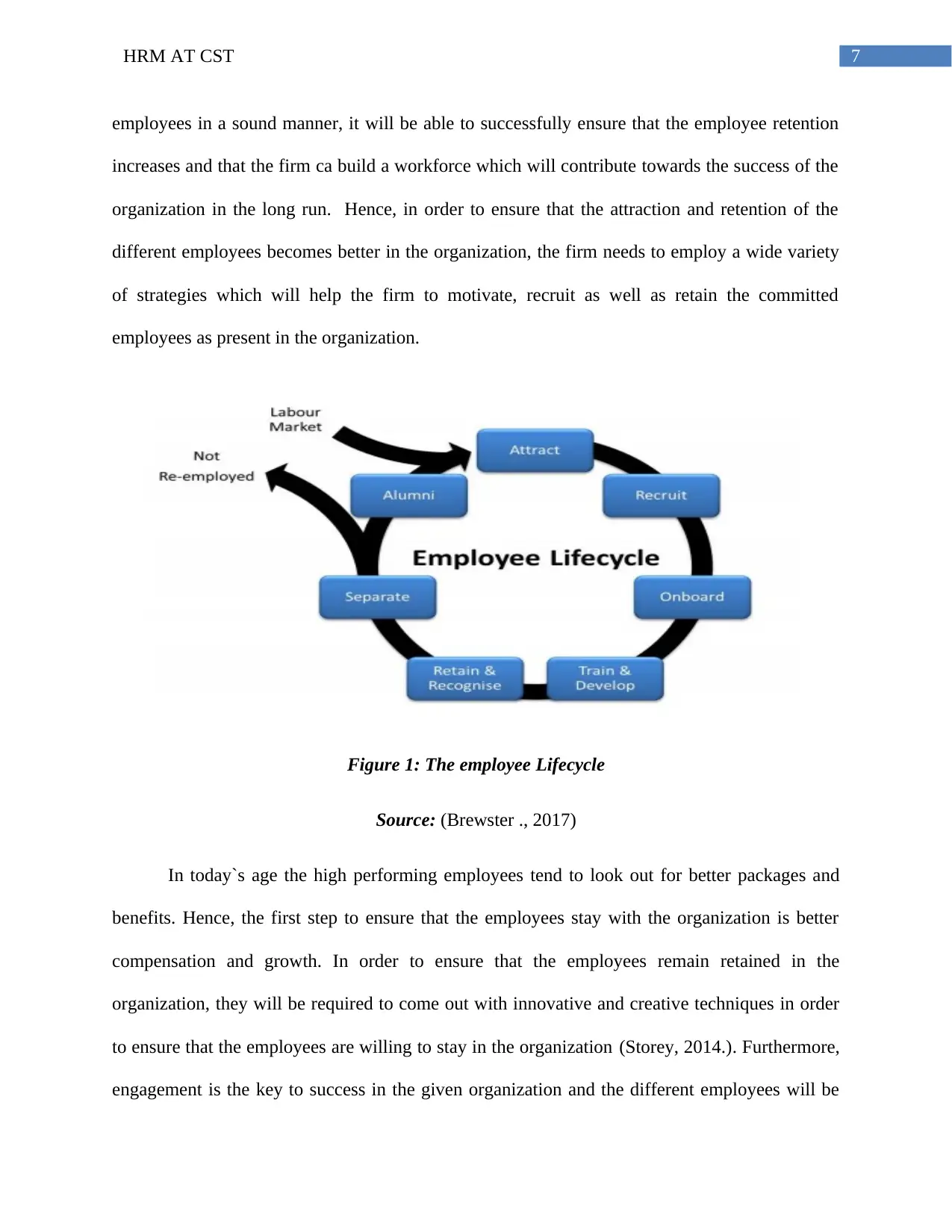
7HRM AT CST
employees in a sound manner, it will be able to successfully ensure that the employee retention
increases and that the firm ca build a workforce which will contribute towards the success of the
organization in the long run. Hence, in order to ensure that the attraction and retention of the
different employees becomes better in the organization, the firm needs to employ a wide variety
of strategies which will help the firm to motivate, recruit as well as retain the committed
employees as present in the organization.
Figure 1: The employee Lifecycle
Source: (Brewster ., 2017)
In today`s age the high performing employees tend to look out for better packages and
benefits. Hence, the first step to ensure that the employees stay with the organization is better
compensation and growth. In order to ensure that the employees remain retained in the
organization, they will be required to come out with innovative and creative techniques in order
to ensure that the employees are willing to stay in the organization (Storey, 2014.). Furthermore,
engagement is the key to success in the given organization and the different employees will be
employees in a sound manner, it will be able to successfully ensure that the employee retention
increases and that the firm ca build a workforce which will contribute towards the success of the
organization in the long run. Hence, in order to ensure that the attraction and retention of the
different employees becomes better in the organization, the firm needs to employ a wide variety
of strategies which will help the firm to motivate, recruit as well as retain the committed
employees as present in the organization.
Figure 1: The employee Lifecycle
Source: (Brewster ., 2017)
In today`s age the high performing employees tend to look out for better packages and
benefits. Hence, the first step to ensure that the employees stay with the organization is better
compensation and growth. In order to ensure that the employees remain retained in the
organization, they will be required to come out with innovative and creative techniques in order
to ensure that the employees are willing to stay in the organization (Storey, 2014.). Furthermore,
engagement is the key to success in the given organization and the different employees will be
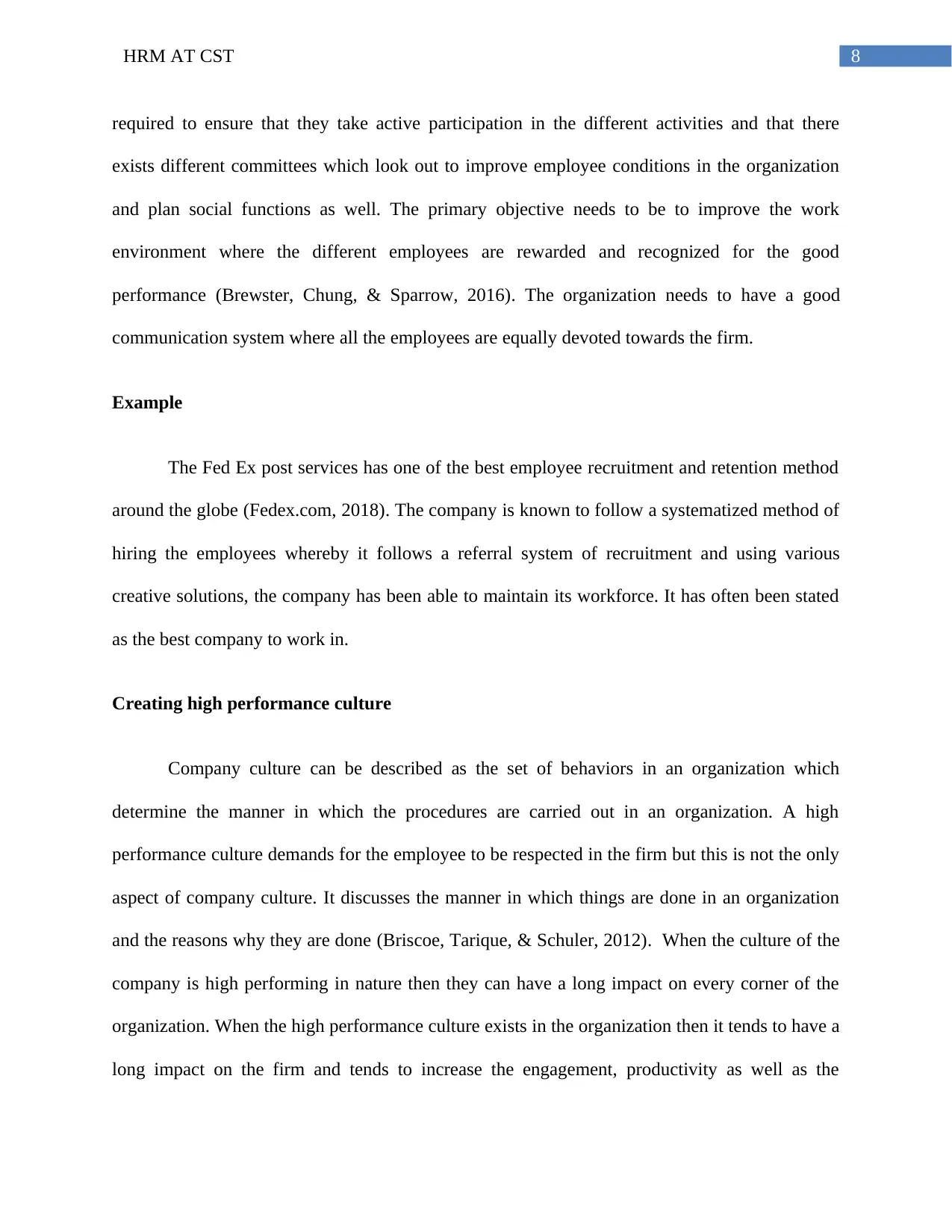
8HRM AT CST
required to ensure that they take active participation in the different activities and that there
exists different committees which look out to improve employee conditions in the organization
and plan social functions as well. The primary objective needs to be to improve the work
environment where the different employees are rewarded and recognized for the good
performance (Brewster, Chung, & Sparrow, 2016). The organization needs to have a good
communication system where all the employees are equally devoted towards the firm.
Example
The Fed Ex post services has one of the best employee recruitment and retention method
around the globe (Fedex.com, 2018). The company is known to follow a systematized method of
hiring the employees whereby it follows a referral system of recruitment and using various
creative solutions, the company has been able to maintain its workforce. It has often been stated
as the best company to work in.
Creating high performance culture
Company culture can be described as the set of behaviors in an organization which
determine the manner in which the procedures are carried out in an organization. A high
performance culture demands for the employee to be respected in the firm but this is not the only
aspect of company culture. It discusses the manner in which things are done in an organization
and the reasons why they are done (Briscoe, Tarique, & Schuler, 2012). When the culture of the
company is high performing in nature then they can have a long impact on every corner of the
organization. When the high performance culture exists in the organization then it tends to have a
long impact on the firm and tends to increase the engagement, productivity as well as the
required to ensure that they take active participation in the different activities and that there
exists different committees which look out to improve employee conditions in the organization
and plan social functions as well. The primary objective needs to be to improve the work
environment where the different employees are rewarded and recognized for the good
performance (Brewster, Chung, & Sparrow, 2016). The organization needs to have a good
communication system where all the employees are equally devoted towards the firm.
Example
The Fed Ex post services has one of the best employee recruitment and retention method
around the globe (Fedex.com, 2018). The company is known to follow a systematized method of
hiring the employees whereby it follows a referral system of recruitment and using various
creative solutions, the company has been able to maintain its workforce. It has often been stated
as the best company to work in.
Creating high performance culture
Company culture can be described as the set of behaviors in an organization which
determine the manner in which the procedures are carried out in an organization. A high
performance culture demands for the employee to be respected in the firm but this is not the only
aspect of company culture. It discusses the manner in which things are done in an organization
and the reasons why they are done (Briscoe, Tarique, & Schuler, 2012). When the culture of the
company is high performing in nature then they can have a long impact on every corner of the
organization. When the high performance culture exists in the organization then it tends to have a
long impact on the firm and tends to increase the engagement, productivity as well as the
⊘ This is a preview!⊘
Do you want full access?
Subscribe today to unlock all pages.

Trusted by 1+ million students worldwide
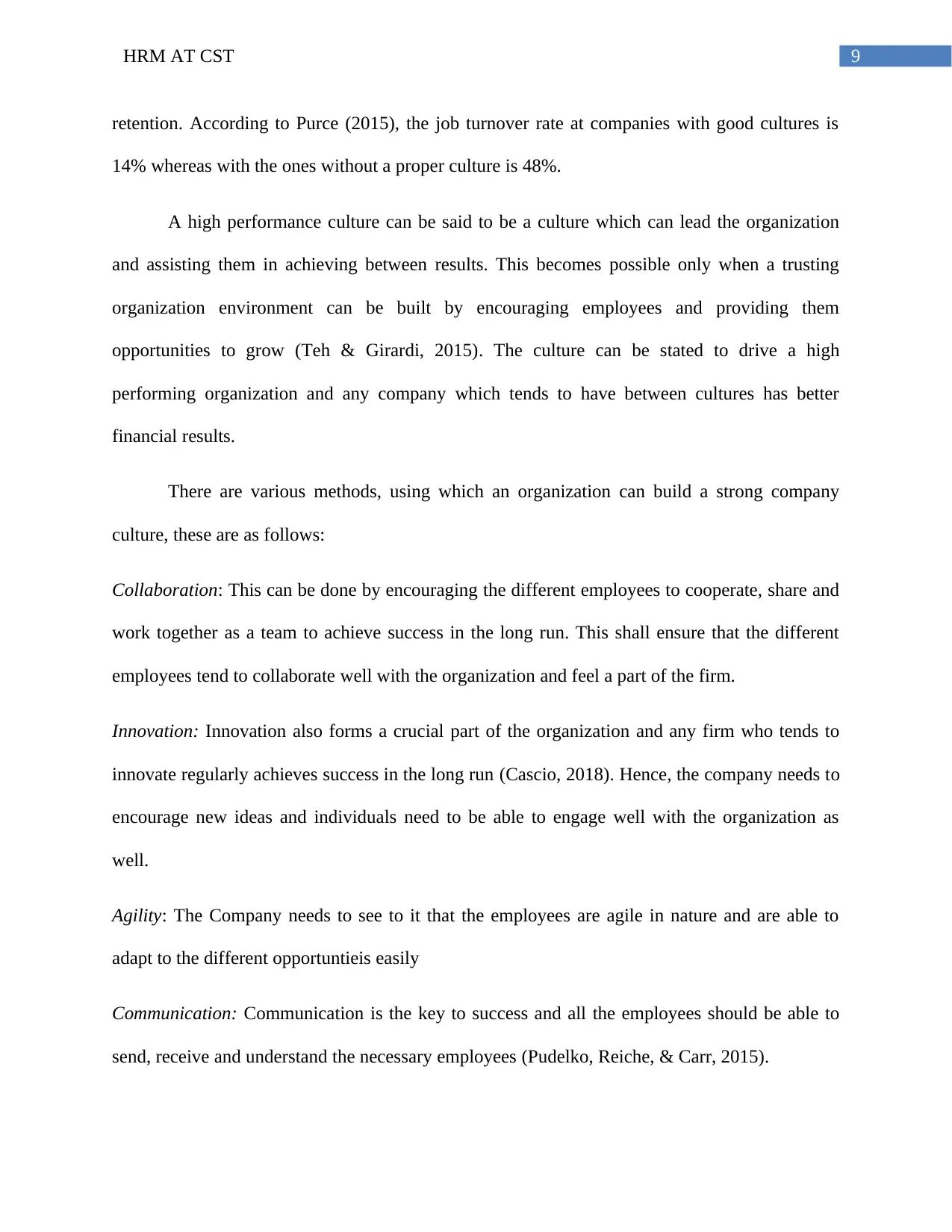
9HRM AT CST
retention. According to Purce (2015), the job turnover rate at companies with good cultures is
14% whereas with the ones without a proper culture is 48%.
A high performance culture can be said to be a culture which can lead the organization
and assisting them in achieving between results. This becomes possible only when a trusting
organization environment can be built by encouraging employees and providing them
opportunities to grow (Teh & Girardi, 2015). The culture can be stated to drive a high
performing organization and any company which tends to have between cultures has better
financial results.
There are various methods, using which an organization can build a strong company
culture, these are as follows:
Collaboration: This can be done by encouraging the different employees to cooperate, share and
work together as a team to achieve success in the long run. This shall ensure that the different
employees tend to collaborate well with the organization and feel a part of the firm.
Innovation: Innovation also forms a crucial part of the organization and any firm who tends to
innovate regularly achieves success in the long run (Cascio, 2018). Hence, the company needs to
encourage new ideas and individuals need to be able to engage well with the organization as
well.
Agility: The Company needs to see to it that the employees are agile in nature and are able to
adapt to the different opportuntieis easily
Communication: Communication is the key to success and all the employees should be able to
send, receive and understand the necessary employees (Pudelko, Reiche, & Carr, 2015).
retention. According to Purce (2015), the job turnover rate at companies with good cultures is
14% whereas with the ones without a proper culture is 48%.
A high performance culture can be said to be a culture which can lead the organization
and assisting them in achieving between results. This becomes possible only when a trusting
organization environment can be built by encouraging employees and providing them
opportunities to grow (Teh & Girardi, 2015). The culture can be stated to drive a high
performing organization and any company which tends to have between cultures has better
financial results.
There are various methods, using which an organization can build a strong company
culture, these are as follows:
Collaboration: This can be done by encouraging the different employees to cooperate, share and
work together as a team to achieve success in the long run. This shall ensure that the different
employees tend to collaborate well with the organization and feel a part of the firm.
Innovation: Innovation also forms a crucial part of the organization and any firm who tends to
innovate regularly achieves success in the long run (Cascio, 2018). Hence, the company needs to
encourage new ideas and individuals need to be able to engage well with the organization as
well.
Agility: The Company needs to see to it that the employees are agile in nature and are able to
adapt to the different opportuntieis easily
Communication: Communication is the key to success and all the employees should be able to
send, receive and understand the necessary employees (Pudelko, Reiche, & Carr, 2015).
Paraphrase This Document
Need a fresh take? Get an instant paraphrase of this document with our AI Paraphraser
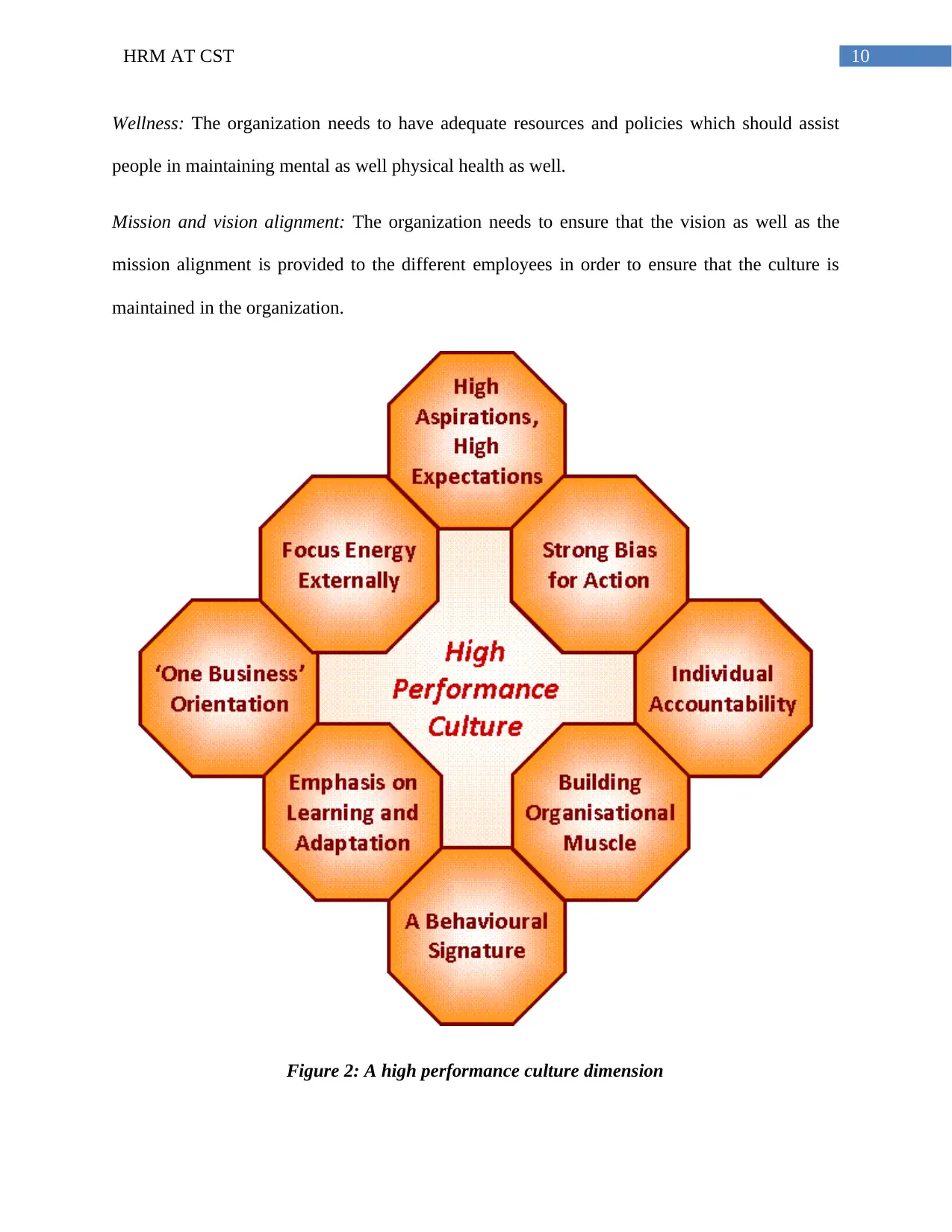
10HRM AT CST
Wellness: The organization needs to have adequate resources and policies which should assist
people in maintaining mental as well physical health as well.
Mission and vision alignment: The organization needs to ensure that the vision as well as the
mission alignment is provided to the different employees in order to ensure that the culture is
maintained in the organization.
Figure 2: A high performance culture dimension
Wellness: The organization needs to have adequate resources and policies which should assist
people in maintaining mental as well physical health as well.
Mission and vision alignment: The organization needs to ensure that the vision as well as the
mission alignment is provided to the different employees in order to ensure that the culture is
maintained in the organization.
Figure 2: A high performance culture dimension
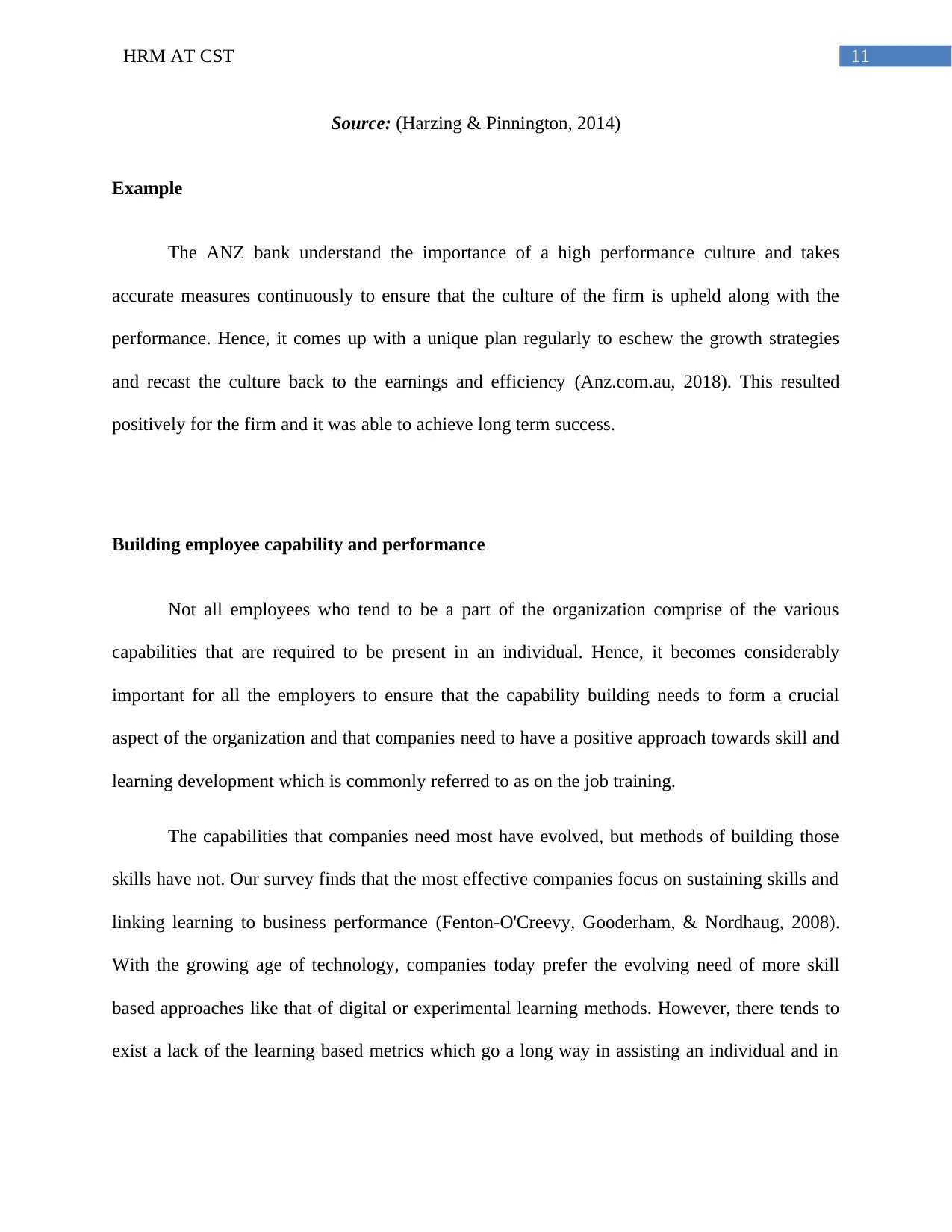
11HRM AT CST
Source: (Harzing & Pinnington, 2014)
Example
The ANZ bank understand the importance of a high performance culture and takes
accurate measures continuously to ensure that the culture of the firm is upheld along with the
performance. Hence, it comes up with a unique plan regularly to eschew the growth strategies
and recast the culture back to the earnings and efficiency (Anz.com.au, 2018). This resulted
positively for the firm and it was able to achieve long term success.
Building employee capability and performance
Not all employees who tend to be a part of the organization comprise of the various
capabilities that are required to be present in an individual. Hence, it becomes considerably
important for all the employers to ensure that the capability building needs to form a crucial
aspect of the organization and that companies need to have a positive approach towards skill and
learning development which is commonly referred to as on the job training.
The capabilities that companies need most have evolved, but methods of building those
skills have not. Our survey finds that the most effective companies focus on sustaining skills and
linking learning to business performance (Fenton-O'Creevy, Gooderham, & Nordhaug, 2008).
With the growing age of technology, companies today prefer the evolving need of more skill
based approaches like that of digital or experimental learning methods. However, there tends to
exist a lack of the learning based metrics which go a long way in assisting an individual and in
Source: (Harzing & Pinnington, 2014)
Example
The ANZ bank understand the importance of a high performance culture and takes
accurate measures continuously to ensure that the culture of the firm is upheld along with the
performance. Hence, it comes up with a unique plan regularly to eschew the growth strategies
and recast the culture back to the earnings and efficiency (Anz.com.au, 2018). This resulted
positively for the firm and it was able to achieve long term success.
Building employee capability and performance
Not all employees who tend to be a part of the organization comprise of the various
capabilities that are required to be present in an individual. Hence, it becomes considerably
important for all the employers to ensure that the capability building needs to form a crucial
aspect of the organization and that companies need to have a positive approach towards skill and
learning development which is commonly referred to as on the job training.
The capabilities that companies need most have evolved, but methods of building those
skills have not. Our survey finds that the most effective companies focus on sustaining skills and
linking learning to business performance (Fenton-O'Creevy, Gooderham, & Nordhaug, 2008).
With the growing age of technology, companies today prefer the evolving need of more skill
based approaches like that of digital or experimental learning methods. However, there tends to
exist a lack of the learning based metrics which go a long way in assisting an individual and in
⊘ This is a preview!⊘
Do you want full access?
Subscribe today to unlock all pages.

Trusted by 1+ million students worldwide
1 out of 22
Related Documents
Your All-in-One AI-Powered Toolkit for Academic Success.
+13062052269
info@desklib.com
Available 24*7 on WhatsApp / Email
![[object Object]](/_next/static/media/star-bottom.7253800d.svg)
Unlock your academic potential
Copyright © 2020–2025 A2Z Services. All Rights Reserved. Developed and managed by ZUCOL.



